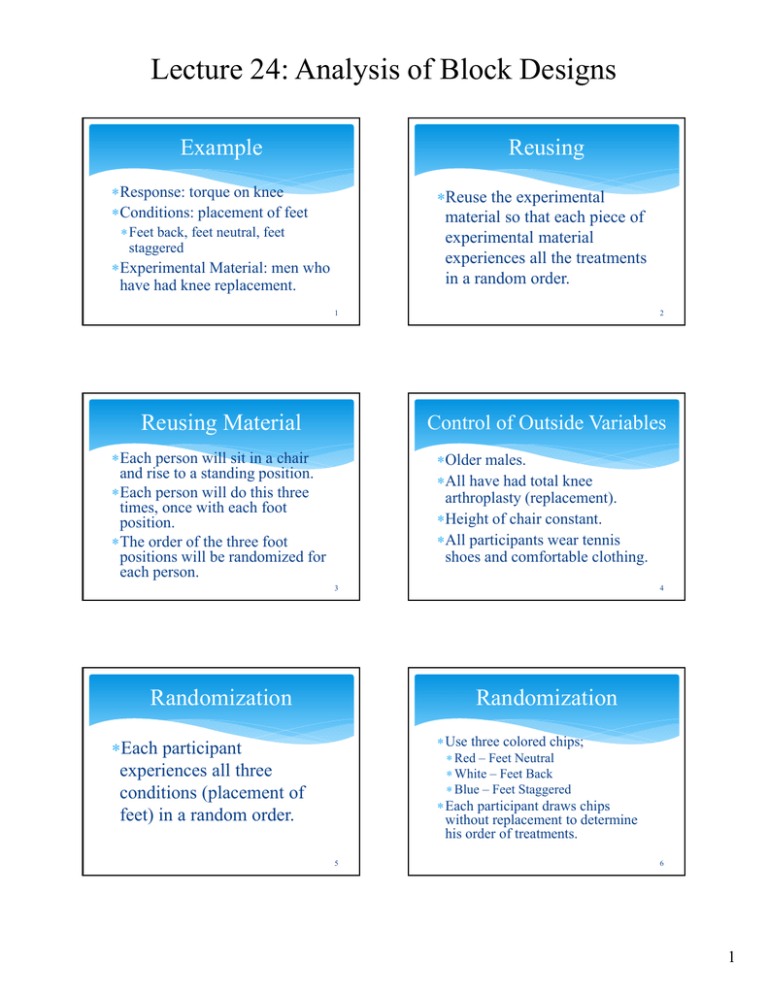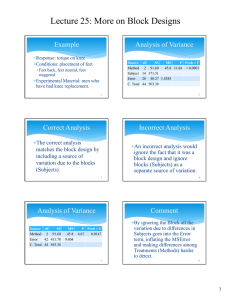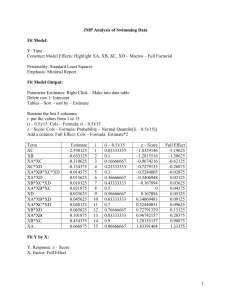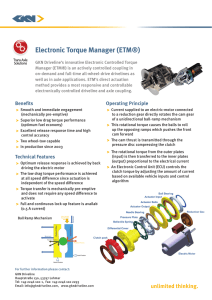Lecture 24: Analysis of Block Designs Example Reusing
advertisement

Lecture 24: Analysis of Block Designs Example Reusing Response: torque on knee Conditions: placement of feet Reuse the experimental material so that each piece of experimental material experiences all the treatments in a random order. Feet back, feet neutral, feet staggered Experimental Material: men who have had knee replacement. 1 2 Reusing Material Control of Outside Variables Each person will sit in a chair and rise to a standing position. Each person will do this three times, once with each foot position. The order of the three foot positions will be randomized for each person. Older males. All have had total knee arthroplasty (replacement). Height of chair constant. All participants wear tennis shoes and comfortable clothing. 3 Randomization 4 Randomization Use three colored chips; Each participant experiences all three conditions (placement of feet) in a random order. Red – Feet Neutral White – Feet Back Blue – Feet Staggered Each participant draws chips without replacement to determine his order of treatments. 5 6 1 Lecture 24: Analysis of Block Designs Replication Sample Size Tables There are 15 participants. The treatments (foot positions) are replicated 15 times. Although constructed for completely randomized designs, the sample size tables can give us insight into the size of the detectable difference in treatment means. 7 Sample Size Tables 8 Informal Analysis 3 groups. Alpha = 0.05, Beta = 0.10 n = 15 per group. Can detect between a 1.2 and 1.4 standard deviation difference in treatment sample means. Method Neutral Back Staggered Mean 24.1 Nm 21.7 Nm 20.7 Nm Std. Dev. 3.8582 2.9835 2.3719 9 10 Estimated Effects Neutral: 24.1 – 22.167 = 1.933 Nm 1.933 Back: 21.7 – 22.167 = –0.467 Nm –1.467 Nm – 0.467 Staggered: 20.7 – 22.167 = – 1.467 11 12 2 Lecture 24: Analysis of Block Designs Estimated Effects Analysis of Variance Staggered reduces the torque the most, on average. Neutral increases the torque the most, on average. Are these effects statistically significant? Source Method Subject Error C. Total df SS MS F Prob > F 2 91.60 45.8 31.84 < 0.0001 14 371.51 28 40.27 1.4383 44 503.38 13 14 Test of Hypothesis Test of Hypothesis H0: all method effects are 0 HA: some method effects are not 0 F = 31.84, P-value < 0.0001 Because the P-value is so small, we should reject the null hypothesis and conclude that some of the method effects are not zero. 15 Multiple Comparisons 16 Multiple Comparisons Compute the LSD for comparing the Method Means. ∗ 1 Level Neutral Back Staggered 1 LSD = 2.04841 1.4383 Mean 24.1 21.7 20.7 A B C Levels not connected by the same letter are significantly different. = 2.04841(0.43792) = 0.897 17 18 3 Lecture 24: Analysis of Block Designs Conclusion JMP Analyze – Fit Model Response – Torque Construct Model Effects Each method produces a different mean torque which is statistically different from the other methods. Method Subject 19 20 Response Torque Summary of Fit RSquare RSquare Adj Root Mean Square Error Mean of Response Observations (or Sum Wgts) Comment 0.919994 0.874277 1.199305 22.16667 45 Analysis of Variance Source Model Error C. Total DF 16 28 44 The summary RSquare and Model F-Ratio are not helpful in summarizing the effects of Methods on Torque. Sum of Squares Mean Square F Ratio 28.9442 20.1234 463.10667 1.4383 Prob > F 40.27333 503.38000 <.0001* Effect Tests Source Method Subject Nparm 2 14 DF 2 14 Sum of Squares 91.60000 371.50667 F Ratio Prob > F <.0001* 31.8424 <.0001* 18.4493 21 Comment 22 Comment The Subject term quantifies the variation in experimental material. The Error term quantifies the lack of consistency of Method effects across Subjects. Method RSquare . ⁄ 0.182 . 18.2% of the variation in Torque is explained by the different Methods. 23 24 4 Lecture 24: Analysis of Block Designs Analysis of Variance Source Method Subject Interaction Error C. Total df 2 14 28 0 44 Replication SS 91.60 371.51 40.27 0 503.38 Although there is replication of the Methods (15 subjects do all three Methods) there is not replication of the Method by Subject combinations. 25 26 “Error” “Error” There is no way to estimate error due to different trials of Method for each Subject because each Subject uses each Method only once. The Error term is actually the interaction between Method and Subject. In a Block design this interaction is assumed to be no different from random error. 27 Interpretation 28 Interpretation If some treatments are better with some blocks and worse for others, the “Error” term will be large and so there may be no statistically significant consistent treatment effects. If the F test for treatment effects turns out to be not statistically significant, this could be due to no treatment effects or to no consistent treatment effects. 29 30 5







